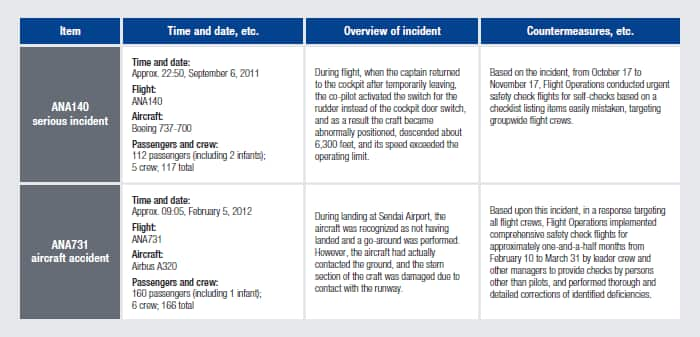In the fiscal year ended March 2012, there were seven cases of aircraft accidents and serious incidents involving the ANA Group. Although the serious incidents included two events that were not caused by the ANA Group, the number of cases exceeded the norm. In particular, the September 6, 2011 serious incident involving ANA140, the February 5, 2012 aircraft accident involving ANA731, and the June 20, 2012 aircraft accident involving ANA956
* were widely reported in the media. The ANA Group deeply regrets the concern and inconveniences that resulted. In the event of aircraft accidents and serious incidents, the Transport Safety Board of the Ministry of Land, Infrastructure and Transport of Japan conducts investigations. While actively cooperating with investigations by public organizations, the ANA Group also conducts internal investigations, investigates causes and gathers proposals to prevent recurrence. The Group’s efforts will not stop with thorough implementation of these countermeasures, and will extend to groupwide activities to further heighten safety standards.
* Because the cause of the ANA956 air incident is currently under investigation, details will be reported as appropriate on ANA’s website.

 While it is easy to say, “We’re working for safety,” flawlessly maintaining safety is no easy matter.
While it is easy to say, “We’re working for safety,” flawlessly maintaining safety is no easy matter.During an extended period with few accidents or problems, lapsing into the self-satisfied attitude of “We’re safe enough” and slacking off in safety initiatives becomes a possibility. The above accidents and major incidents can be seen as signs of organizational self-satisfaction and laxness.
Companies that go beyond platitudes to actually maintain safety are characterized by each employee’s continuing stance of always asking himself or herself, “Are we really safe?” Because the self-satisfied, lax attitude of a single person can be the cause of a major accident or problem, the two points “individual awareness” and “continuity” are vital in safety initiatives.
The ANA Group continues to inspect organizational safety issues through means such as questionnaires for all employees, including the president and officers, to evaluate its safety culture. As part of the ongoing questioning of oneself, moving ahead without making the safety culture evaluations a mere formality requires facing up to the strong expectations set by society regarding safety, and resolving issues on one’s own.
As the ANA Group interacts with its customers and other diverse stakeholders, I expect it to firmly respond to the expectations of society, to continue to review its initiatives, and to continue to maintain a level of safety that leads the world.




















